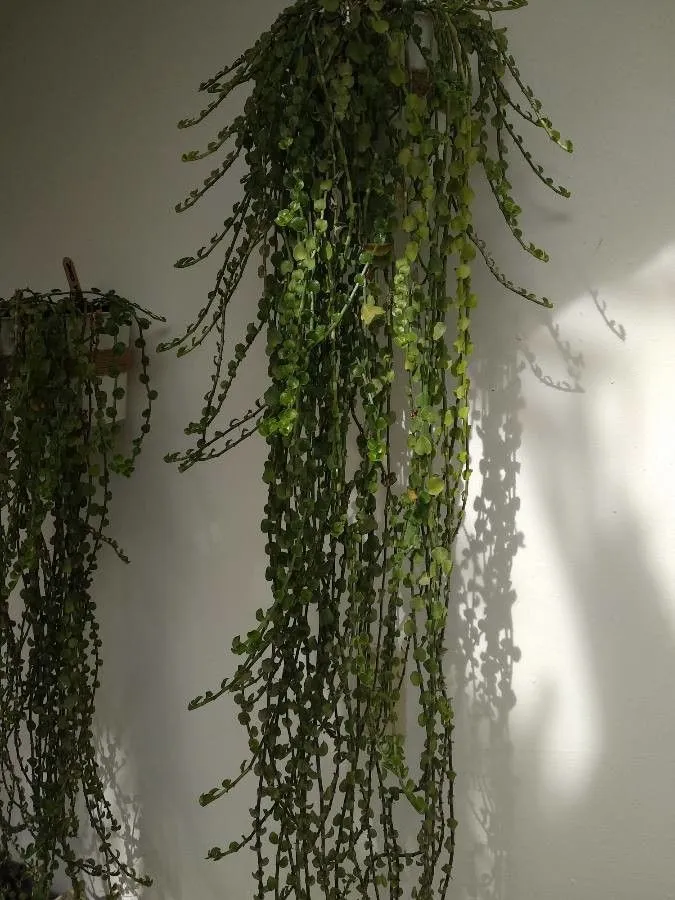
Author: (L.) Kunth
Bibliography: F.W.H.von Humboldt, A.J.A.Bonpland & C.S.Kunth, Nov. Gen. Sp. 1: 65 (1816)
Year: 1816
Status: accepted
Rank: species
Genus: Peperomia
Vegetable: False
Observations: Mexico to Trop. America
Yerba linda, scientifically known as Peperomia rotundifolia, is a captivating plant species that falls within the Piperaceae family. Described by renowned botanists F.W.H. von Humboldt, A.J.A. Bonpland, and C.S. Kunth in their seminal work “Nov. Gen. Sp.” in 1816, this plant has garnered significant attention due to its distinctive characteristics and widespread habitat.
Native to regions extending from Mexico to Tropical America, Yerba linda thrives in diverse environments, reflecting its adaptability and resilience. This plant is characterized by its delicate, rounded foliage that effortlessly enhances various indoor and outdoor settings. The small, succulent leaves are typically glossy and green, creating a lush, compact appearance that is both appealing and functional for ground cover or as a decorative houseplant.
Peperomia rotundifolia’s adaptability makes it a popular choice among gardeners and plant enthusiasts. Its low-maintenance nature requires minimal care, making it ideal for those looking to add greenery to their spaces without the need for extensive upkeep. The plant’s preference for indirect light and well-drained soil adds to its versatility, allowing it to flourish in various growing conditions.
The historical significance of Yerba linda, as chronicled by Humboldt, Bonpland, and Kunth, further underscores its importance in botanical studies. Their classification and documentation have provided valuable insights into the biodiversity of tropical regions and the intricate relationships within plant families.
In summary, Yerba linda (Peperomia rotundifolia) is more than just an aesthetically pleasing plant; it is a testament to botanical exploration and the rich flora of tropical America. Its ease of care, coupled with its historical and ecological relevance, makes it a cherished addition to any plant collection.
Eng: yerba linda
Swe: linspeperomia
En: Yerba linda
Fr: Ti moron
Sv: Linspeperomia
© copyright of the Board of Trustees of the Royal Botanic Gardens, Kew.
© copyright of the Board of Trustees of the Royal Botanic Gardens, Kew.
© copyright of the Board of Trustees of the Royal Botanic Gardens, Kew.
Taken Sep 27, 2021 by Caro lien (cc-by-sa)
Taken Jul 23, 2021 by Trap Hers (cc-by-sa)
Taken Feb 18, 2021 by Pennyleann Cavender (cc-by-sa)
Taken Jan 14, 2021 by cecile ff (cc-by-sa)
Taken Feb 1, 2022 by Elke Stief (cc-by-sa)
Taken May 29, 2013 by OTS – Oviedo-Brenes, Federico (cc-by-nc-sa)
Taken Apr 17, 2019 by OTS – O. Vargas (cc-by-nc-sa)
Taken May 29, 2013 by OTS – Oviedo-Brenes, Federico (cc-by-nc-sa)
Taken Apr 19, 2022 by manuseitz (cc-by-sa)
Taken Jul 23, 2021 by Trap Hers (cc-by-sa)
Taken Nov 13, 2022 by brotherwolf (cc-by-sa)
Taken Jan 1, 1900 by EOL − Frank Vincentz (cc-by-sa)
Taken Sep 26, 2021 by lron (cc-by-sa)
Taken Apr 19, 2022 by manuseitz (cc-by-sa)
Taken Sep 2, 2021 by Marzanna Bug (cc-by-sa)
Taken Oct 8, 2017 by Daniel Barthelemy (cc-by-nc)
Taken Sep 26, 2020 by ifp660 (cc-by-sa)
Taken Oct 11, 2020 by senzy (cc-by-sa)
Taken Feb 21, 2022 by AxL M. (cc-by-sa)
Taken Jun 19, 2021 by Corti Cristina (cc-by-sa)
Taken Sep 16, 2020 by Doris Erlenbach (cc-by-sa)
Taken Sep 4, 2020 by Giusy (cc-by-sa)
Taken Jul 26, 2020 by Aga klon (cc-by-sa)
Taken Apr 17, 2019 by OTS – R. Aguilar (cc-by-nc-sa)
Taken May 29, 2013 by OTS – Oviedo-Brenes, Federico (cc-by-nc-sa)
Growth habit>: Vine, Forb/herb
Family: Myrtaceae Author: (F.Muell.) K.D.Hill & L.A.S.Johnson Bibliography: Telopea 6: 402 (1995) Year: 1995 Status:…
Family: Rubiaceae Author: Pierre ex A.Froehner Bibliography: Notizbl. Bot. Gart. Berlin-Dahlem 1: 237 (1897) Year:…
Family: Sapindaceae Author: Koidz. Bibliography: J. Coll. Sci. Imp. Univ. Tokyo 32(1): 38 (1911) Year:…
Family: Asteraceae Author: A.Gray Bibliography: Pacif. Railr. Rep.: 107 (1857) Year: 1857 Status: accepted Rank:…
Family: Fabaceae Author: Medik. Bibliography: Vorles. Churpfälz. Phys.-Ökon. Ges. 2: 398 (1787) Year: 1787 Status:…
Family: Aspleniaceae Author: (Cav.) Alston Bibliography: Bull. Misc. Inform. Kew 1932: 309 (1932) Year: 1932…